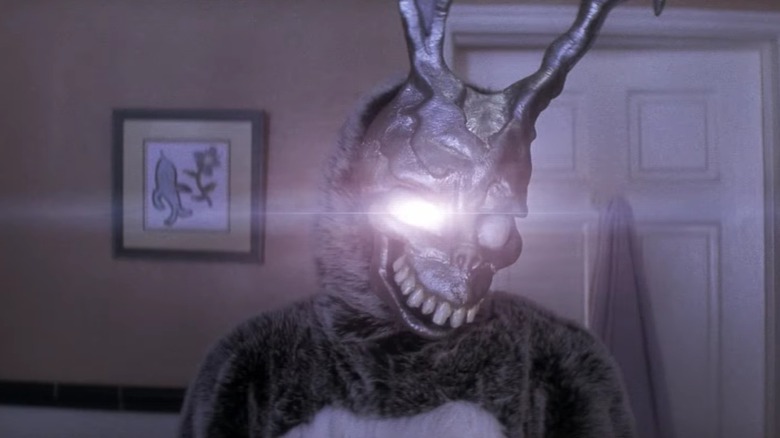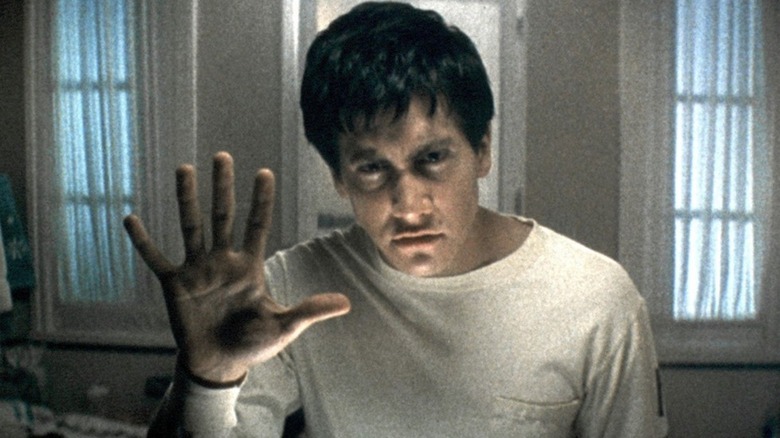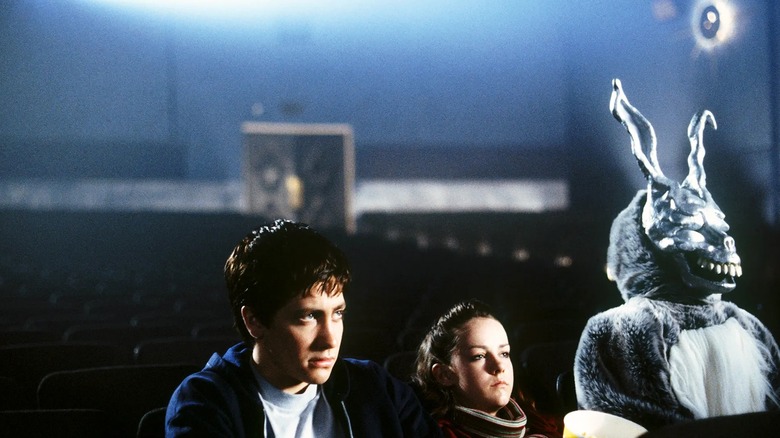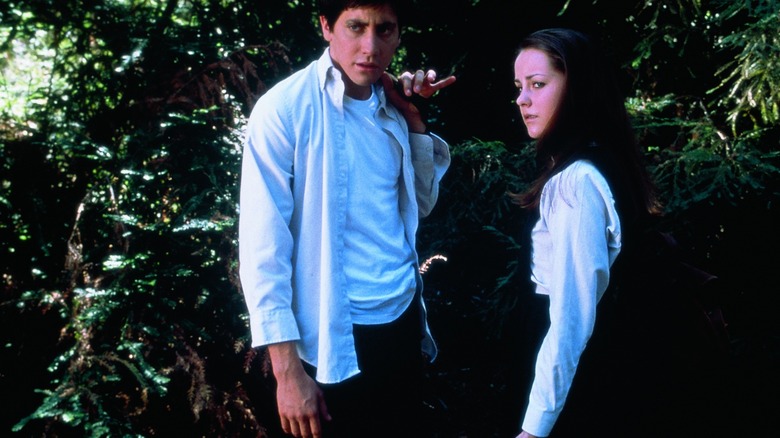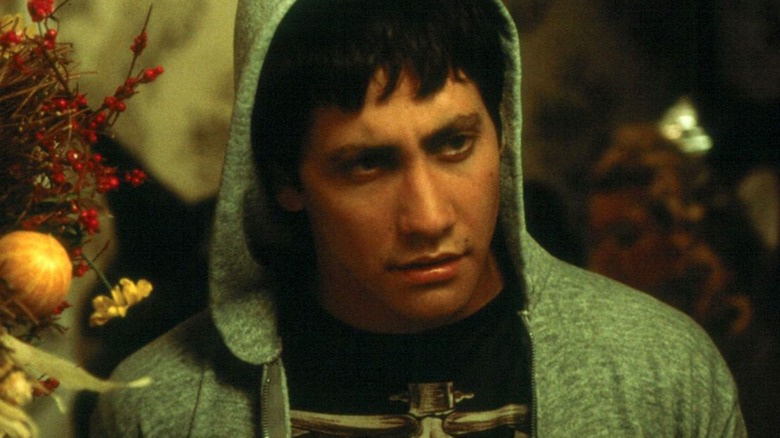Donnie Darko's Mysterious Frank The Rabbit, Explained
This post contains spoilers for "Donnie Darko."
Richard Kelly's "Donnie Darko" opens with a nightmarish conversation in the dark. An ominous-looking rabbit named Frank (James Duval) warns a young Donnie (Jake Gyllenhaal) about the world's imminent end — in 28 days, six hours, 42 minutes, and 12 seconds, to be precise. Although Frank looks more like a man in a rabbit costume than a tall bipedal rabbit, there is something eerily otherworldly about his presence, with the suit's soulless eyes adding a touch of the macabre. Since this fateful meeting, Donnie is guided by Frank towards a particular end, and the volatile, melancholy teen undergoes several rites of passage over the span of 28 days. Frank's mysterious influence over Donnie is just one baffling aspect of the film, as the mind-boggling nature of the events invites varied interpretations, often blurring the lines between reality and dreams, and ones where the two overlap.
It might be tempting to paint Frank as a figment of Donnie's imagination, or even a vivid hallucination manifested by his fractured psyche, but Kelly's Director's Cut etches a far more intriguing (and complicated) picture. The key to understanding Frank and the events of "Donnie Darko" lies within the fictitious book "The Philosophy of Time Travel," which is briefly glimpsed in the theatrical version as a philosophical manifesto written by Grandma Death/ Roberta Sparrow (Patience Cleveland). Kelly includes pages from the book in the Director's Cut, which offer a canonical interpretation of the time travel paradox that Donnie is at the epicenter of. Although the book does not answer every burning question, the best we can do is attempt to contextualize what we know about Frank against the contents of Sparrow's book and gauge which theories hold up the best.
What you need to know before analyzing Frank the Rabbit
To keep things brisk and simple, let us establish a few key terms from Sparrow's book and apply them to our understanding of what happens. Sparrow refers to immediate reality as the Primary Universe, where the laws of the space-time continuum function within the norm, but often deviate due to anomalies in the Fourth Dimension. When such an anomaly occurs, a parallel reality or Tangent Universe gets created — this universe is an identical copy of the original but is highly unstable due to its inability to sustain itself, doomed to inevitably collapse upon itself after some time. If the Tangent Universe suffers no further anomalies, the collapse will be a safe one, not affecting causality in the Primary Universe. However, if this is not the case, the volatile collapse of the Tangent Universe will affect the Primary Universe, causing the end of the world as we know it.
To prevent such a catastrophe from occurring, a Living Receiver is chosen from the Tangent Universe to guide this anomaly (known as The Artifact) back to the Primary Universe, ensuring the safe collapse of the former so that the latter remains intact. If we are to apply these rules to the film, then the jet plane engine that collapses in Donnie's room at the beginning is the anomaly (The Artifact), and Donnie, the Living Receiver, needs to guide it back to the original reality to ensure everyone's survival. This means that a chunk of "Donnie Darko" takes place in the Tangent Universe, and Donnie's quest is to trigger a chain of events potent enough to facilitate the time travel back to the OG universe on October 2nd: the day Frank warned Donnie about the end of the world.
Frank the Rabbit was born in the Tangent Universe
Where does Frank fit into this grand plan to save the world? This brings us to the concepts of the Manipulated Living and Dead, along with the special abilities that each category possesses. Sparrow states that every person who is connected to the Living Receiver (Donnie) in the Tangent Universe is the Manipulated Living, who cautiously nudge him toward the intended goal to ensure the survival of their original selves in the primary reality. If anyone connected to Donnie dies in the duplicated universe, they become the Manipulated Dead, who can move through time and directly guide the Living Receiver and warn them of the disaster to come. Frank clearly fits this description, as a version of him does die in the Tangent Universe on Halloween Night, implying that he traveled backward in time to warn Donnie as Frank the Rabbit.
In both realities, Frank is Elizabeth's (Maggie Gyllenhaal) boyfriend, but in the Tangent Universe, Donnie ends up shooting Frank in the eye while he's wearing a bunny-rabbit costume during Halloween after Gretchen (Jena Malone) is accidentally run over by his car. After his death in the Tangent Universe turns Frank into the Manipulated Dead, he travels back in time within the duplicated universe to warn Donnie, orchestrating events that lead up to his death to preserve the chain of causality. By luring Donnie out on October 2nd, he saves him from being crushed so that the quest to return the Artifact can be initiated and etches a path along with the Manipulated Living to ensure that he is able to create a portal back to the Primary Universe before the mirrored one's collapse.
While Frank the Rabbit ceases to exist after the Tangent Universe's collapse, what happens to his counterpart?
It's a mad world in the Primary Universe
Once Donnie realizes his purpose in the Tangent Universe (which is now on the verge of collapse), he uses his telekinetic abilities to sever a jet plane engine from the sky and sends it back through a portal created with water (an element of transmutation in the book). Back in the Primary Universe — where time had stopped for 28 days right before October 2nd — space-time starts functioning as usual and Donnie wakes up in his bedroom with a start. The events in the Tangent Universe seem like an absurd fever dream, making him laugh, but he chooses to sacrifice himself, as he possesses the foreknowledge that the jet engine will crash in his room at any moment. It does, preventing any of the tragedies that occurred in the Tangent Universe from happening, as Donnie's death eliminates the epicenter of these causal events. The temporal correction of the Primary Universe is now complete.
In the Primary Universe, Frank the Rabbit does not exist, but Frank does, even though he does not have any inkling about his counterpart's eerie, significant role in the parallel universe. However, it is implied that the counterparts of the Manipulated Living and the Dead are haunted by a vague, yet acute sense of loss after Donnie's death. Frank touches his eye while wearing his Halloween costume as if plagued by a phantom wound and haunted by something he can never articulate. Every other person connected to Donnie in the Tangent Universe, including Gretchen (who survives in this reality), is tugged by this sense of familiarity even though they never get a chance to form a bond with him due to his sacrifice, similar to a memory from a half-forgotten dream that feels a bit too real for comfort.
Frank dares Donnie to shatter convention, and he does
"Donnie Darko" is about growing pains, where teenage angst and grief morph into something more immediate and life-altering, changing the trajectory of more than one universe. On a microcosmic level, Donnie's emotional volatility allows Frank to feed upon his vulnerabilities, where he urges Donnie to push the limits of socially sanctioned behavior and accepted norms. While this errs on the edge of dangerous behavioral patterns, every transgression Frank nudges Donnie toward conceals a morally sound intent, allowing the latter to embrace his flaws and work towards forging relationships rooted in trust and acceptance. His romantic involvement with Gretchen in the Tangent Universe serves a specific purpose, where the subsequent loss of this deep and fulfilling relationship is meant to leave Donnie heartbroken enough for him to understand the dire necessity of his sacrifice.
Frank is like a boogeyman lurking in the shadows, constantly poking at Donnie's hidden, nightmarish impulses and egging him on to indulge in unencumbered absurdities that aim to uncover unsavory truths. Although these emotions invite intense inner turmoil, he must engage with them, as his value as a Living Receiver (who successfully fulfills his role) depends on it. Being the chosen one is a heavy burden, one that Donnie is willing to carry once he realizes what it means to love and lose in a world built on this very universal principle. For Donnie, dying for his loved ones feels natural, as opposed to a heroic feat that will be remembered or preserved by history. It is a quiet, selfless sacrifice, which haunts even those who never had the pleasure of getting to know him when he was alive. What is more heartbreaking and unconventional than that?
